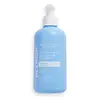What's inside
What's inside
 Key Ingredients
Key Ingredients

 Benefits
Benefits

 Concerns
Concerns

 Ingredients Side-by-side
Ingredients Side-by-side

Centella Asiatica Extract 41%
CleansingWater
Skin ConditioningLauryl Hydroxysultaine
CleansingGlycerin
HumectantDisodium Cocoamphodiacetate
CleansingPotassium Cocoyl Glycinate
Sodium Chloride
MaskingPotassium Cocoate
EmulsifyingSodium Lauroyl Glutamate
Vitis Vinifera Fruit Extract
Skin ConditioningPyrus Malus Fruit Extract
Skin ConditioningCarica Papaya Fruit Extract
Skin ConditioningPrunus Mume Fruit Extract
HumectantMadecassoside
Antioxidant1,2-Hexanediol
Skin ConditioningXylitylglucoside
HumectantAnhydroxylitol
HumectantXylitol
HumectantNiacinamide
SmoothingAcrylates/C10-30 Alkyl Acrylate Crosspolymer
Emulsion Stabilising3-O-Ethyl Ascorbic Acid
Skin ConditioningTrehalose
HumectantButylene Glycol
HumectantPanthenol
Skin ConditioningAgave Tequilana Leaf Extract
AstringentGlucose
HumectantCaprylic/Capric Triglyceride
MaskingHexylene Glycol
EmulsifyingPentylene Glycol
Skin ConditioningCitric Acid
BufferingPotassium Benzoate
PreservativeEthylhexylglycerin
Skin ConditioningDisodium EDTA
Centella Asiatica Extract 41%, Water, Lauryl Hydroxysultaine, Glycerin, Disodium Cocoamphodiacetate, Potassium Cocoyl Glycinate, Sodium Chloride, Potassium Cocoate, Sodium Lauroyl Glutamate, Vitis Vinifera Fruit Extract, Pyrus Malus Fruit Extract, Carica Papaya Fruit Extract, Prunus Mume Fruit Extract, Madecassoside, 1,2-Hexanediol, Xylitylglucoside, Anhydroxylitol, Xylitol, Niacinamide, Acrylates/C10-30 Alkyl Acrylate Crosspolymer, 3-O-Ethyl Ascorbic Acid, Trehalose, Butylene Glycol, Panthenol, Agave Tequilana Leaf Extract, Glucose, Caprylic/Capric Triglyceride, Hexylene Glycol, Pentylene Glycol, Citric Acid, Potassium Benzoate, Ethylhexylglycerin, Disodium EDTA
Water
Skin ConditioningCocamidopropyl Betaine
CleansingSodium Lauroyl Sarcosinate
CleansingPhenoxyethanol
PreservativeSodium Chloride
MaskingSalicylic Acid
MaskingAcrylates/C10-30 Alkyl Acrylate Crosspolymer
Emulsion StabilisingAllantoin
Skin ConditioningGlycerin
HumectantInulin
Skin ConditioningSodium Cocoamphoacetate
CleansingDisodium Cocoamphodiacetate
CleansingXanthan Gum
EmulsifyingDisodium EDTA
Ethylhexylglycerin
Skin ConditioningAlpha-Glucan Oligosaccharide
CleansingWater, Cocamidopropyl Betaine, Sodium Lauroyl Sarcosinate, Phenoxyethanol, Sodium Chloride, Salicylic Acid, Acrylates/C10-30 Alkyl Acrylate Crosspolymer, Allantoin, Glycerin, Inulin, Sodium Cocoamphoacetate, Disodium Cocoamphodiacetate, Xanthan Gum, Disodium EDTA, Ethylhexylglycerin, Alpha-Glucan Oligosaccharide
 Reviews
Reviews

Ingredients Explained
These ingredients are found in both products.
Ingredients higher up in an ingredient list are typically present in a larger amount.
Acrylates/C10-30 Alkyl Acrylate Crosspolymer is a synthetic polymer. It is used to thicken and improve the texture of products. Due to its properties, it can prevent water and oil ingredients from separating.
Disodium Cocoamphodiacetate is a surfactant and helps cleanse skin. It is created from the fatty acids of coconut oil.
Surfactants help rinse oil, dirt, and other pollutants easily from skin. It has a faint fruit-like scent.
Disodium EDTA plays a role in making products more stable by aiding other preservatives.
It is a chelating agent, meaning it neutralizes metal ions that may be found in a product.
Disodium EDTA is a salt of edetic acid and is found to be safe in cosmetic ingredients.
Learn more about Disodium EDTAEthylhexylglycerin (we can't pronounce this either) is commonly used as a preservative and skin softener. It is derived from glyceryl.
You might see Ethylhexylglycerin often paired with other preservatives such as phenoxyethanol. Ethylhexylglycerin has been found to increase the effectiveness of these other preservatives.
Glycerin is already naturally found in your skin. It helps moisturize and protect your skin.
A study from 2016 found glycerin to be more effective as a humectant than AHAs and hyaluronic acid.
As a humectant, it helps the skin stay hydrated by pulling moisture to your skin. The low molecular weight of glycerin allows it to pull moisture into the deeper layers of your skin.
Hydrated skin improves your skin barrier; Your skin barrier helps protect against irritants and bacteria.
Glycerin has also been found to have antimicrobial and antiviral properties. Due to these properties, glycerin is often used in wound and burn treatments.
In cosmetics, glycerin is usually derived from plants such as soybean or palm. However, it can also be sourced from animals, such as tallow or animal fat.
This ingredient is organic, colorless, odorless, and non-toxic.
Glycerin is the name for this ingredient in American English. British English uses Glycerol/Glycerine.
Learn more about GlycerinChances are, you eat sodium chloride every day. Sodium Chloride is also known as table salt.
This ingredient has many purposes in skincare: thickener, emulsifier, and exfoliator.
You'll most likely find this ingredient in cleansers where it is used to create a gel-like texture. As an emulsifier, it also prevents ingredients from separating.
There is much debate on whether this ingredient is comedogenic. The short answer - comedogenic ratings don't tell the whole story. Learn more about comegodenic ratings here.
The concensus about this ingredient causing acne seems to be divided. Research is needed to understand if this ingredient does cause acne.
Scrubs may use salt as the primary exfoliating ingredient.
Learn more about Sodium ChlorideWater. It's the most common cosmetic ingredient of all. You'll usually see it at the top of ingredient lists, meaning that it makes up the largest part of the product.
So why is it so popular? Water most often acts as a solvent - this means that it helps dissolve other ingredients into the formulation.
You'll also recognize water as that liquid we all need to stay alive. If you see this, drink a glass of water. Stay hydrated!
Learn more about Water